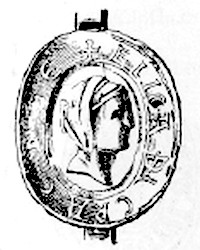Hopfennohe Castle
The Outbound Castle Hopfenohe was in the 1939 abgesiedelten community and deserted Hopfenohe on the site of present-day military training area Grafenwöhr which the Upper Palatinate town of Grafenwoehr belongs.
history
"Hopfenahe" is mentioned in the founding deed of May 6, 1119 of the Michelfeld Monastery founded by Bishop Otto I. von Bamberg (the place is probably named after a brook where hops grow). The family of the gentlemen von Pettendorf-Lengenfeld-Hopfenohe is also named after Hopfenohe . The last male representative from the Pettendorfer family was Friedrich III. from Pettendorf. His castle at Hopfenohe is said to have stood on the site of the later rectory (house number 1). After the Lords of Pettendorf died out, the descent of Hopfennohe began. Via the heiress Heilika von Lengenfeld , part of the Pettendorfer's property came to Otto V. von Scheyern , the father of Otto I. the Rotkopf , the first Wittelsbach Duke of Bavaria. When the market rights were transferred to the village of Urbach in 1144 , this also received the Hopfenohe market.
From around 1200 onwards, the Ratzenbergs were the masters of the part of Hopfenohe that did not belong to Michelfeld Monastery . 1334 sold z. B. Chunrad the Ratzenberger von Hopfenohe and his brother Mathes gave the monastery various goods in Altkreisendorf (now part of Kirchenthumbach ) in favor of their cousin Marquard Ratzenberger, then a monk and 1335-1357 abbot in Michelfeld monastery. From 1380 to 1460 the Degenreuter (also called Tedenreuter) are based in Hopfenohe. Between 1460 and 1767 Hopfenohe belonged to the Schlammerstorfern , a noble family from Upper Palatinate with their headquarters in Schlammersdorf .

In 1560–85 a new castle was built on the east side of the village, but this was destroyed again during the Thirty Years' War and no longer rebuilt. Christoph Leonhard von Schlammerstorf built a forge in Hopfenohe in 1608 (house number 13 at Schmie ). Balthasar Jakob von Schlammerstorf zu Hopfenohe was a. a. 1615 to 1621 district judge in Auerbach. He was a close confidante of Elector Friedrich V of the Palatinate and was entrusted by him with various diplomatic missions. As a colonel, he also took part in the Battle of White Mountain on November 8, 1620. After this defeat he appeared in 1626 as a Danish colonel in the battle of Lutter ; In 1627 he was named as a mugger near Burgthann , in 1629 as a Swedish agent in Nördlingen , then as captain in Neustadt an der Aisch , again as a mugger between Nuremberg and Neumarkt and finally in 1632 as major general of the city of Nuremberg . 1635 seems to have been the year of death of Balthasar Jakob von Schlammersdorf. His brother Christoph Bernhard von Schlammerstorf, forest master of the Waldsassen Abbey , received the Hofmark Hopfenohe in 1621 after his brother was ostracized. Since he did not want to become Catholic during the re-Catholicization of 1628, he had to leave the country. Elector Maximilian of Bavaria let Hopfenohe move in. After the Peace of Westphalia , the Schlammerstorfer got their property back. Friedrich Wilhelm von Schlammerstorf, Catholic and son of the former district judge, became the new lord of the court. This was followed by his cousin Hans Peter in 1675.
In 1767, the Auerbach town clerk Johann Samuel Martin Schenkl acquired the Hopfenohe estate and the hereditary title of nobility associated with it. Schenkl transferred the Hofmark Hopfenohe in 1794 to his eldest son Franz Anton Schenkl, government director of the finance chamber in Amberg . In 1786 he had also acquired the Portenreuth estate. His son, Government Councilor Joseph von Schenkl, owned both estates from 1808 to 1825. When he died in 1825, his heirs sold the old rights to the state and the property to the Hopfenoher farmers.
During the Nazi era, the Grafenwöhr military training area was expanded from 1936 to 1939. Hopfenohe remained for a few years, because the houses were targeted at farmers, i.e. H. the workers who erected targets for the artillery at the military training area, and their families used them as homes. After the end of the war, displaced persons also used the residential buildings. In 1948 the United States Army had the site finally evacuated and released the building for demolition. The church of Hopfenohe, which had become a ruin, was saved from further deterioration. On September 11, 2005, the completion of the work on the now secured church ruins was celebrated with a service.
Web links
- Kugler's Chronicles - Hopfenohe
- Hans-Jürgen Kugler: Hopfenohe: history of a parish. 1997
- Rudolf Weber: Hopfenohe
Individual evidence
- ↑ Colonel James E. Saenz starts a conservation project for the US Army with various types of fruit trees. Hopsless blooms again
- ↑ Blooming villages like the former Hopfenohe belonged to the catchment area of the city of Auerbach. Dilapidated church ruins as a silent witness
Coordinates: 49 ° 41 ′ 46.9 ″ N , 11 ° 39 ′ 39.2 ″ E

